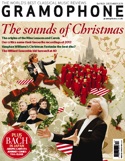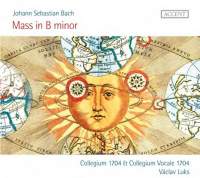Texte paru dans: / Appeared in:
*

GRAMOPHONE (12 /2013)
Pour s'abonner /
Subscription information
Accent
ACC24283

Code-barres / Barcode : 4015023242838
Reviewer: David
Vickers
Luks moves from
the ‘Czech Bach’ to the Leipzig one
Having made several excellent recordings of sacred music for the Dresden
Hofkapelle by Zelenka, it is only natural that the Czech ensemble Collegium
1704 and Václav Luks turn their attention to Bach’s Mass in B minor – the
first half of which was presented by Bach to the Elector of Saxony in 1733.
Luks provides an engaging essay on artistic choices when tackling the work;
he misrepresents some small but fundamental tenets of the
‘one-voice-perpart’ theories but nonetheless balances tradition and newer
thinking by adopting the principle of concertists (ie those who sing the
solos and also perform in all choruses) working alongside a group of
ripienists (who contribute only to the choruses). Therefore, rather than
Parrott’s choir of just 10, Luks fields a vocal group of 21 (six of whom
perform solos, although it also turns out that many choral passages just
feature the ‘concertists’).
Whether listeners care about performance practice ideologies or not, there
is no mistaking Collegium 1704’s qualities: the superb choir sing with
judicious weight and solemnity in the opening chords of the Kyrie,
after which warmly sensual oboes and bassoons make lovely contributions to
the long orchestral ritornello; once the choir re-enter, small instrumental
details are sensitively enunciated. Sopranos Hana Blažíková and Sophie
Harmsen combine neatly in ‘Christe eleison’, although the smooth orchestral
accompaniment seems more earnest than life-affirming. There’s plenty of
sparkle and vigour in the trumpet-laden opening of the Gloria and,
upon reaching ‘Et in terra pax’, the oboes convey a more lilting pastoral
mood than one usually hears. Helena Zemanová’s intelligent violin obbligato
in the ‘Laudamus te’ perhaps seems studied rather than spontaneous, whereas
there’s a looser conversational flexibility from Marián Krejčik and horn
player Erwin Wieringa in the ‘Quoniam’. There is perfect balance between
throbbing basso continuo line, punctuating flutes and expressive choral
declamation in the ‘Crucifixus’, and the Sanctus is interpreted as a
quick jig. Overall, this is yet another highly accomplished Mass in B minor
rather than an essential new perspective – but there’s nothing wrong with
that.
Cliquez l'un ou l'autre
bouton pour découvrir bien d'autres critiques de CD
Click either button for many other reviews


